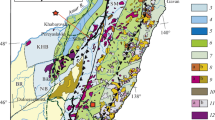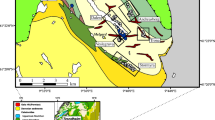Abstract
The relationship between bismuth (Bi) mineral speciation and redox state in three types of granitoids from the Uetsu region, northeast Japan is investigated. Electron microprobe analysis of Bi minerals, sphalerite, Mg-Fe-bearing carbonate minerals, and muscovite, as well as sulfur isotope analysis of sulfide minerals and microthermometric study of fluid inclusions reveal that Bi mineral speciation varies according to the redox state of the granitoids. For example, native bismuth and bismuthinite are abundant and Bi sulfosalts are rare in the lowest fS2 and fO2 mineralized zones of the reduced Iwafune granite (S-type, ilmenite-series) while Bi sulfosalts (Bi3+) are abundant and trace amounts of native bismuth (Bi0) and bismuthinite are found in the highest fS2 and fO2 mineralized zones of the oxidized Wasada granodiorite (I-type, magnetite-series). Bismuthinite is a major Bi mineral, and native bismuth and Bi sulfosalts occur in only minor amounts in the mineralized zones of the Nishitagawa granodiorite (I-type, ilmenite-series), which has intermediate fS2 and fO2 to that of the Iwafune and Wasada samples. Our study indicates that Bi mineral speciation related to granitic intrusive activity is controlled by the redox state of the magmatism, such that native bismuth is typical of reducing conditions, whereas Bi sulfosalts are typical of oxidizing conditions.









Similar content being viewed by others
References
Agency for Natural Resources and Energy (1982) Report of regional geological survey of Uetsu Area (I). Agency of Natural Resources and Energy, Tokyo, pp 1–164, in Japanese
Barton PB Jr, Skinner BJ (1979) Sulfide mineral stabilities. In: Barnes HL (ed) Geochemistry of hydrothermal ore deposits, 2nd edn. Wiley-Interscience, pp 278–403
Barton PBJ, Toulmin P (1966) Phase relations involving sphalerite in the Fe-Zn-S system. Econ Geol 61:815–849
Burnham CB, Ohmoto H (1980) Late-stage processes of felsic magmatism. Mining Geol Spec Issue 8:1–12
Cepedal A, Fuertes-Fuente M, Martin-Izard A, González-Nistal S, Rodríguez-Pevida L (2006) Tellurides, selenides and Bi-mineral assemblages from the Rìo Narcea Gold Belt, Asturias, Spain: genetic implications in Au-Cu and Au skarns. Mineral Petrol 87:277–304
Chappell BW, White ARJ (1974) Two contrasting granite types. Pacific Geol 8:173–174
Ciobanu CL, Cook NJ (2002) Tellurides, selenides (and Bi-sulphosalts) in gold deposits. 11th Quadrennial IAGOD Symposium and Geocongress, Windhoek, CD Volume of Extended Abstracts, Geol Surv Namibia
Cockerton ABD, Tomkins AG (2012) Insights into the liquid bismuth collector model through analysis of the Bi-Au Stormont skarn prospect, northwest Tasmania. Econ Geol 107:667–682
Cook NJ, Ciobanu CL (2004) Bismuth tellurides and sulphosalts from the Larga hydrothermal system, Metaliferi Mts, Romania: paragenesis and genetic significance. Mineral Mag 68:301–321
Craig JR, Barton PB (1973) Thermochemical approximations for sulfosalts. Econ Geol 68:493–506
Dobbe RTM (1991) Tellurides, selenides and associated minerals in the Tunaberg copper deposits, SE Bergslagen, Central Sweden. Mineral Petrol 44:89–106
Einaudi MT, Hedenquist JW, Inan EE (2003) Sulfidation state of fluids in active and extinct hydrothermal systems: transitions from porphyry to epithermal environments. Soc Econ Geol Spec Publ 10:285–313
Ellis AJ, Hiroi Y (1997) Secondary siderite-oxide-sulphide and carbonate-andalusite assemblages in cordierite granulites from Sri Lanka: post-granulite facies fluid evolution during uplift. Contrib Mineral Petrol 127:315–335
Hollister LS, Grissom GC, Peters EK, Stowell HH, Sisson VB (1987) Confirmation of the empirical correlation of A1 in hornblende with pressure of solidification of calc-alkaline plutons. Am Mineral 72:231–239
Imai A, Anan S (2000) Sulfur isotope study and re-examination of ore mineral assemblage of the Hol Kol and the Tul Mi Chung skarn-type copper-gold deposits of the Suan mining district, Korean Peninsula. Resour Geol 50:213–228
Ishihara S (1977) The magnetite-series and ilmetite-series granitic rocks. Min Geol 27:293–305
Ishihara S (1981) The granitoid series and mineralization. 75th Anniv Vol Econ Geol, pp 458–484
Ishihara S (1998) Granitoid series and mineralization in the Circum-Pacific Phanerozoic granitic belts. Resour Geol 48:219–224
Ishihara S, Sasaki A (2002) Paired sulfur isotopic belts: late Cretaceous-Paleogene ore deposits of Southwest Japan. Bull Geol Surv Japan 53:461–477
Ishihara S, Sasaki A, Terashima S (1983) Granitoids and mineralization in the Uetsu area, Japan. Bull Geol Surv Japan 34:11–26 (in Japanese with English abstract)
Izumino Y, Nakashima K (2014) Bi minerals from the ore deposits associated with the Wasada granodiorite, Yamagata Prefecture, Japan. Japan Mag Mineral Petrol Sci 43:174–183 (in Japanese with English abstract)
Izumino Y, Nakashima K (2015a) Bismuth minerals from the Fukueison mine, Yamagata Prefecture, Japan. Japan Mag Mineral Petrol Sci 44:205–209 (in Japanese with English abstract)
Izumino Y, Nakashima K (2015b) Bismuth minerals from the W-Mo-Sn deposits hosted in the Iwafune granitoids, Niigata Prefecture, Japan. J Mineral Petrol Sci (in press)
Izumino Y, Nakashima K, Nagashima M (2013) Makovickyite and cupromakovickyite from the Obari mine, Yamagata Prefecture, Japan. J Mineral Petrol Sci 108:94–100
Izumino Y, Nakashima K, Nagashima M (2014) Cuprobismutite group minerals (cuprobismutite, hodrušhite, kupčíkite and padĕraite), other Bi-sulfosalts and Bi-tellurides from the Obari mine, Yamagata Prefecture, Japan. J Mineral Petrol Sci 109:177–190
Kagashima S, Shimura T (2001) Two stage fractional crystallization of the porphyritic biotite granite from the Iwafune granitoids in the Budo Mountains, Niigata Prefecture, Japan. J Geol Soc Japan 107:515–530 (in Japanese with English abstract)
Kanisawa S (1983) Chemical characteristics of biotites and hornblends of Late Mesozoic to Early Tertiary granitic rocks in Japan. Geol Soc Am Mem 159:129–134
Kawano Y, Ueda Y (1966) K-Ar dating on the igneous rocks in Japan (IV)—granitic rocks in the northeastern Japan. Jour Japan Assoc Min Petr Econ Geol 56:41–55 (in Japanese with English abstract)
Kuroda Y (1963) Mutual relations between the metamorphic rocks in the northeast Japan. Earth Sci (Chikyu Kagaku) 67:21–29 (in Japanese with English abstract)
Lee CH, Park HI (1995) Some Pb-Bi-Sb-S minerals from the Dunjeon gold mine, northern Taebaegsan mining district, Korea. Resour Geol 45:323–329
Lu HZ, Liu Y, Wang C, Xu Y, Li H (2003) Mineralization and fluid inclusion study of the Shizhuyuan W-Sn-Bi-Mo-F skarn deposit, Hunan Province, China. Econ Geol 98:955–974
Maruoka T, Koeberl C, Hancox PJ, Reimold WU (2003) Sulfur geochemistry across a terrestrial Permian-Triassic boundary section in the Karoo Basin, South Africa. Earth Planet Sci Lett 206:101–117
Mueller AG, Awrance LM, Muhling J, Pooley GD (2012) Mineralogy and PTX relationships of the Archea Hannan South Au-Cu (Co-Bi) deposit, Kalgoorlie, Western Australia: thermodynamic constraints on the formation of a zoned intrusion-related skarn. Econ Geol 107:1–24
Mustard R (2001) Granite-hosted gold mineralization at Timbarra, northern New South Wales. Miner Deposita 36:542–562
Ohmoto H (1986) Stable isotope geochemistry of ore deposits. In: Valley JW, Talor HPJ, O’Neil JR (ed) Stable isotopes in high temperatutre geological processes, Rev Mineral 16:491–570
Paar WH, Chen TT, Meixner H (1980) Pb-Bi-(Cu)-sulfosalts in Paleozoic gneisses and schists from Oberpinzgau, Salzgurg province, Austria. Tschermaks Min Petr Mitt 27:1–16
Richards JP, Dang G, Dudka SF, Wong ML (2003) The Nui Phao tungsten-fluorite-copper-gold-bismuth deposit, northern Vietnum: an opportunity for sustainable development. Explor Mining Geol 12:61–70
Roedder E (1984) Fluid inclusions. Rev Mineral 12:1–646
Sasaki A, Ishihara S (1979) Sulfur isotope composition of the magnetite-series and ilmenite-series granitoids in Japan. Contrib Mineral Petrol 68:107–115
Sasaki A, Ishihara S (1980) Sulfur isotope characteristics of granitoids and related mineral deposits in Japan. Proc 5th IAGOD Quad Symp, 325–335
Sato K (2012) Sedimentary crust and metallogeny of granitoid affinity: implications from the geotectonic histories of the Circum-Japan Sea Region, central Andes and southeastern Australia. Resour Geol 62:329–351
Scott SD (1983) Chemical behaviour of sphalerite and arsenopyrite in hydrothermal and metamorphic environments. Mineral Mag 47:427–435
Shimazu M, Koseki K, Obi I (1961) Uraniferous ore deposits in Asahi and Obari areas, Yamagata Prefecture. Rept Geol Surv Japan 190:173–183 (in Japanese with English abstract)
Sillitoe RH, Hedenquist JW (2003) Linkages between volcanotectonic settings, ore-fluid compositions, and epithermal precious metal deposits. Soc Econ Geol Spec Publ 10:315–343
Skirrow RG, Walshe JL (2002) Reduced and oxidized Au-Cu-Bi iron oxide deposits of the Tennant Creek Inlier, Australia. Econ Geol 97:1167–1202
Sugai (1973) On the chemical composition and some of their properties of the so-called Paleozoic clayslates and hornfelses in the Oguni district, Yamagata Prefecture. Geology and Natural Resources of Yamagata Prefecture, Japan. Professor Kuman Haraguchi Memorial Volume, 47–56 (in Japanese with English abstract)
Sugaki A, Ueno H, Shimada N, Kusachi I, Kitakazse A, Hayashi K, Kojima S, Sanjines O, Sanchez A, Velarde O (1984) Geological study on the polymetallic ore deposits in the Quechisla district. Bolivia Sci Rept Tohoku Univ Ser 3(16):131–198
Takahashi H (1998) Geology and structure of the Nihonkoku Mylonite Zone on the borders of Niigata and Yamagata Prefectures, northeast Japan. J Geol Soc Japan 104:122–136 (in Japanese with English abstract)
Tanelli G (1982) Geological setting, mineralogy and genesis of tungsten mineralization in Dayu district, (People’s Republic of China): an outline. Miner Deposita 17:279–294
Thompson JFH, Sillitoe RH, Baker T, Lang JR, Mortensen JK (1999) Intrusion-related gold deposits associated with tungsten-tin provinces. Miner Deposita 34:323–334
Tooth B, Ciobanu CL, Green L, O’Neill B, Brugger J (2011) Bi-melt formation and gold scavenging from hydrothermal fluids: an experimental study. Geochim Cosmochim Acta 75:5423–5443
Tsuchiya N, Takahashi Y, Yanagisawa Y, Yamamoto T, Kudo K, Komazawa M, Hiroshima T, Naito K (1999) Geological Map of Japan 1: 200000. Murakami, Geological Survey of Japan
Tsukimura K, Sato K, Ishihara S (1987) Regional and temporal variation in FeS content of sphalerites from Japan and its relation to granitoids series. Bull Geol Surv Japan 38:227–246
Uchida E, Endo S, Makino M (2007) Relationship between solidification depth of granitic rocks and formation of hydrothermal ore deposits. Resour Geol 57:47–56
Wones DR, Eugster HP (1965) Stability of biotite: experiment, theory and application. Am Mineral 50:1228–1272
Acknowledgments
Special thanks are due to Emeritus Prof. Hidehiko Shimazaki for providing the ore specimens from some deposits owned by the University Museum, the University of Tokyo. We are indebted to Mrs. Jun-Ichi Igarashi, Yasunori Kudo, and Toshiro Ito for providing the ore specimens from some deposits. The first author is grateful to Mrs. Naoki Shibuya, Kazunori Miyamato, Yaeita Togashi, and Isami Isobe for helping him in the field surveys and Mrs. Takuya Yamazaki and Yuki Nakajima for helping him in the isotope analyses and fluid inclusion study. We thank Prof. Nigel J. Cook and an anonymous reviewer for their constructive and editorial comments.
Author information
Authors and Affiliations
Corresponding author
Additional information
Editorial handling: B. Lehmann
Electronic supplementary material
Below is the link to the electronic supplementary material.
ESM 1
Table S1 Representative EPMA data of Bi minerals from the Iwafune (IWA samples) *Izumino and Nakashima (2015b) (XLSX 14 kb)
ESM 3
Table S3 Representative EPMA data of Bi minerals from the Nishitagawa (NIS samples) *Izumino and Nakashima (2015a) (XLSX 14 kb)
ESM 4
Table S4 Representative EPMA data of sphalerite from the Iwafune (IWA samples), Wasada (WAS samples) and Nishitagawa (NIS samples) (XLSX 13 kb)
ESM 5
Table S5 Representative EPMA data of Mg-Fe-bearing carbonate minerals from the Iwafune (IWA samples) and Wasada (WAS samples) CO2 was calculated by stoichiometry (XLSX 13 kb)
ESM 6
Table S6 Representative EPMA data of muscovite from the Iwafune (IWA samples), Wasada (WAS samples) and Nishitagawa (NIS samples) (XLSX 18 kb)
ESM 7
Table S7 Analytical results of sulfur isotope compositions of sulfide minerals from the ore deposits in the Uetsu region *Measured by Actlabs Analytical errors ±0.2 ‰ (XLSX 11 kb)
Rights and permissions
About this article
Cite this article
Izumino, Y., Maruoka, T. & Nakashima, K. Effect of oxidation state on Bi mineral speciation in oxidized and reduced granitoids from the Uetsu region, NE Japan. Miner Deposita 51, 603–618 (2016). https://doi.org/10.1007/s00126-015-0629-5
Received:
Accepted:
Published:
Issue Date:
DOI: https://doi.org/10.1007/s00126-015-0629-5




